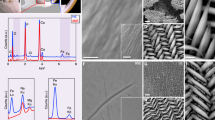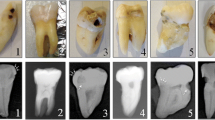Summary
A resolution-enhanced Fourier Transform Infrared (FTIR) Spectroscopic study of the CO3 2− ion in pig enamel of increasing age and maturity has demonstrated the existence of four different, main carbonate locations. The major CO3 2− site arises as a result of the substitution of CO3 2− ions in the positions occupied by PO4 3− ions in the apatitic lattice. In addition, two minor locations have been identified in positions in which the CO3 2− ions substitute for OH− ions. The fourth carbonate group appears to be in an unstable location. Its concentration has been found to decrease with aging and maturation, during which there is a progressive increase in the amount of mineral deposited in the enamel. The distribution of the carbonate ions in the different apatitic sites varies randomly during the formation of the mineral phase in enamel and during its maturation. Although these changes have been shown to be related to changes in the composition of the mineral phase, a comparison of the parameters assessing the degree of crystallinity of the mineral phase from υ2CO3 2− and υ4PO3 2− infrared absorption data reveals a significant discrepancy related to the nonhomogeneous partition of the CO3 2− ion in the mineral phase. After maximum mineralization is reached, the composition of the mature mineral phase is decidedly different than that of the initial mineral deposited; the changes affect principally the concentrations of Ca2+, OH−, and HPO4 2− ions, but not the CO3 2− ions.
Similar content being viewed by others
References
Hallsworth AS, Weatherell JA, Robinson C (1965) Loss of carbonate during the first stages of enamel caries. Caries Res 7:345–348
Cutress TW (1972) The inorganic composition and solubility of dental enamel from several specified population groups. Arch Oral Biol 17:93–109
Sobel AE (1966) Interrelationship of tooth composition, body fluids, diet and caries susceptibility. Ann NY Acad Sci 85:96–109
Elliot JC (1964) The crystallographic structure of dental enamel and related apatites. Ph.D. Thesis, University of London
LeGeros RZ, Trautz OR, LeGros JP, Klein E (1968) Carbonate substitution in the apatitic structure. Bull Soc Chim Fr 1712–1718
Bonel G, Montel G (1966) Sur L' Introduction des ions CO3 2− dans le reseau des apatites calciques. CR Acad Sci C 236:1010–1013
Elliot JC, Holcomb AW, Young RA (1985) Infrared determination of the degree of substitution of hydroxyl by carbonate ions in human enamel. Calcif Tissue Int 37:372–375
Roux P, Bonel G (1980) Evolution structurale sous haute pression des apatites carbonatees de type B. Ann Chim 5:397–405
Vignoles M (1984) Contribution a l'etude des apatites carbonatees de type B. These d' Etat, Institut National Polytechnique de Toulouse
Termine JD, Lundy DR (1973) Hydroxide and carbonate in rat bone mineral and its synthetic analogues. Calcif Tissue Res 13:73–82
Rey C, Collins B, Goehl T, Glimcher MJ (1989) The carbonate environment in bone mineral. A resolution-enhanced Fourier transform infrared spectroscopy study. Calcif Tissue Int 45:157–164
Fukae M, Tanabe T, Ijiri H, Shimizu M (1980) Studies on porcine enamel proteins: a possible original enamel protein. Tsurumi Dent J 6(2):87–94
Roufosse AH, Landis WJ, Sabine NK, Glimcher MJ (1979) Identification of brushite in newly deposited bone mineral from embryonic chicks. J Ultrastruc Res 68:235–255
Kauppinen JR, Moffatt DJ, Mantsch HH, Cameron DG (1981) Fourier self-deconvolution: a method for resolving intrinsically overlapped bands. App Spect 35:271–276
Hannah RW, Swinehart JS (1974) Experiments in techniques of infrared spectroscopy. Perkin E (ed) Norwalk, Conn
Meyer JL, Fowler BO (1982) Lattice defects in nonstoichiometric calcium hydroxylapatite. A chemical approach. Inorg Chem 21:3029–3035
Greenfield DJ, Termine JD, Eanes ED (1974) A chemical study of apatites prepared by hydrolysis of amorphous calcium phosphate in carbonate-containing aqueous solutions. Calcif Tissue Res 14:131–138
Rey C, Lian JB, Grynpas M, Shapiro F, Zylberberg L, Glimcher MJ (1989) Non-apatitic environments in bone mineral: FT-IR detection, biological properties and changes in several disease states. Connect Tissue Res 21:267–273
Termine JD, Posner AS (1966) Infrared determination of the percentage of crystallinity in apatitic calcium phosphates. Nature 241:268–270
Tochon-Danguy HJ (1978) Effect of fluorine on the crystallinity index of bone mineral substance. Fluoride in Bone, Symp CEMO 2nd 1977, pp 73–81
Pellegrino ED, Biltz NM (1971) Mineralization in the chick embryo I: monohydrogen phosphate and carbonate relationships during maturation of the bone crystal complex. Calcif Tissue Res 10:128–135
Nelson DGA, Featherstone JDR (1984) Preparation and characterization of carbonate apatites. Calcif Tissue Int 34:69–81
LeGeros R, Balmain N, Bonel G (1986) Structure and composition of the mineral phase of periosteal bone. J Chem Res Sym 1:8–9
Brudevold F, Soremark R (1967) Structure and chemical organization of teeth, vol 2. Miles AEW (ed) Academic Press, New York, p 247
Engel MB, Hilding OH (1984) Mineralization of developing teeth. Scan Elect Micros IV:1833–1845
Hiller CR, Robinson C, Weatherell JA (1975) Variations in the composition of developing rat incisor enamel. Calcif Tissue Res 18:1–12
Aoba T, Moreno EC (in press) Changes in the nature and composition of enamel mineral during porcine amelogenesis. Calcif Tissue Int
Scott DB, Simmelink JW, Nygaard V (1971) Chemistry and physiology of enamel: a symposium. University of Michigan Prep, Ann Arbor, pp 6–24
Daculsi G, Menanteau J, Kerebel LM, Mitre D (1984) Enamel crystals: size, shape, length and growth process. High resolution TEM and biological study. In: Fearnhead RW, Sugas S (eds) Tooth Enamel Proc Intl Symp Comp Prop Funct Struct Tooth, Enamel IVth. Elsevier, New York, pp 14–18
Glimcher MJ, Daniel EJ, Travis DF, Kamhi S (1965) Electron optical and x-ray diffraction studies of the organization of the inorganic crystals in embryonic bovine enamel. J Ultrastruct Res (suppl) 7:77
Travis DF, Glimcher MJ (1964) The structure and organization of, and the relationship between the organic matrix and the inorganic crystals of embryonic bovine enamel. J Cell Biol 23:447–497
Glimcher MJ (1981) On the form and function of bone: from molecules to organs. Wolff's Law revisited. In: Veis A (ed) The chemistry and biology of mineralized connective tissues. Elsevier/North Holland New York, pp 618–673
Kerebel B, Daculsi G, Kerebel LM (1979) Ultrastructural studies of enamel crystallities. J Dent Res 58:844–851
Garnier P, Voegel JC, Frank RM (1976) Dissolution kinetics of synthetic hydroxyapatite crystal and human enamel. J Biol Buccale 4:323–330
Frazier PD (1968) Adult human enamel: an electron microscopic study of crystallite size and morphology. J Ultrastructr Res 22:1–11
Johnson NN (1966) Differences in the shape of human enamel crystallites after partial destruction by caries. EDTA and carious acids. Arch Oral Biol 11:1412–1424
Jongebloed WL, Van Den Berg PJ, Arends J (1974) The dissolution of hydroxyapatite single crystals in acids. Calcif Tissue Res 15:1–9
Arends J, Jongebloed WL (1981) Apatite single crystals. Formation, dissolution and influence of CO3 2− ions. Recl Trav. Chim Pays-Bas 100:3–9
Marshall AF, Lawless KR (1981) TEM. Study of the central dark line in enamel crystallites. J Dent Res 60:1773–1782
Nakahara H, Kakei M (1984) Central dark line and carbonic anhydrase: problems relating to crystal nucleation in enamel. In: Fearnhead RW, Sugas S (eds) Tooth enamel IV
Daculsi G, LeGeros RZ, (1986) Central darklines in synthetic and biological apatites. Abstracts of IADR meeting. J Dent Res 65:802
Eastoe JE (1960) Organic matrix of tooth enamel. nature 187:411–412
Glimcher MJ, Mechanic GL, Bonar LC, Daniel EJ (1961) The amino acid composition of the organic matrix of decalcified fetal bovine dental enamel. J Biol Chem 236:3210–3213
Glimcher MJ, Mechanic GL, Friberg UA (1964) The amino acid composition of the organic matrix and the neutral-soluble and acid-soluble components of embryonic bovine enamel. Biochem J 93:198–202
Termine JD, Belcourt AB, Christner PJ, Conn KM, Nylen MU (1980) Properties of dissociatively extracted fetal tooth matrix proteins. I. Principal molecular species in developing bovine enamel. J Biol Chem 225:9760–9768
Renugopalakrishnan V, Strawich ES, Horowitz PM, Glimcher MJ (1986) Studies of the secondary structure of amelogenin from bovine tooth enamel. Biochemistry 25:4879–4887
Renugopalakrishnan V, Pattabiraman N, Prabhakaran M, Strawich ES, Glimcher MJ (1989) Tooth enamel protein, amelogenin, has a probably β-spiral internal channel within a single polypeptide chain: preliminary molecular mechanics and dynamics studies. Biopolymers 28:597–603
Renugopalakrishnan V, Prabhakaran M, Huang S-G, Balasubramaniam A, Strawich ES, Glimcher MJ (1989) Secondary structure and limited three-dimensional structure of bovine amelogenin. Connect Tissue Res 22:131–138
Glimcher MJ, Friberg VA, Levine PT (1964) The isolation and amino acid composition of the enamel proteins of erupted bovine teeth. Biochem J 93:202–210
Aoba T, Moriwaki Y, Doi Y, Okazaki M, Takahashi T (1980) Different x-ray scattering from apatite crystals and its relation to amorphous bone mineral. J Osaka University Dental School 20:81–90
Blumenthal NC, Betts F, Posner AS (1975) Effect of carbonate and biological macromolecules on formation and properties of hydroxyapatite. Calcif Tissue Res 18:81–90
Termine JD, Eanes ED, Conn KM (1980) Phosphoprotein modulation of apatite crystallization Calcif Tissue Int 31(3):247–251
Blumenthal NC, Posner AS, Silverman LD, Rosenberg LC (1979) Effect of proteoglycans on in vitro hydroxyapatite formation Calcif Tissue Int 27:75–82
Frank RM (1979) Tooth enamel—current state of the art. J Dent Res 58:689–694
Barroug A, Rey C, Trombe JC, Montel G (1981) Sur la preparation on milien aqueux d' une apatite carbonatee de type AB comparable a' l'email dentaire. CR Acad Sci Paris 292 II, 303–306
LeGros RZ, Kijkowska R, LeGeros JP, Abergas T, Bleiwas H (1987) CO3-for-OH (type A) and CO3-for-PO4 (type B) substitutions in precipitated carbonate apatites. J Dent Res (abstract) 66:190
Bonel G (1972) Contribution a' l'etude de la carbonatation des apatites. Ann Chim 7:127–144
Labarthe JC, Bonel G, Montel G (1973) Sur la structure et les proprietes des apatites carbonatees de type B phosphocalciques. Ann Chim 8:289–301
Tochon-Danguy HJ, Geffroy M, Baud CA (1980) Electron-spin resonance study of the effect of carbonate substitution in synthetic apatites from human teeth. Arch Oral Biol 25:357–361
Young RA, Spooner S (1969) Neutron diffraction studies of human tooth enamel Arch Oral Biol 15:47–63
Brudevold F, Aasenden R, Bakhos T (1982) Preliminary study of posteruptive maturation of teeth in site. Caries Res 16:243–248
Woltgens JHM, Vingerling PA, Witjes F (1980) Chemical evidence of two separate apatite phases in human enamel. Arch Oral Biol 25:435–436
Driessens FC, Heijligers HJ, Borggreven JM, Woltgens JH (1985) Posteruptive maturation of tooth enamel studied with the electron microprobe. Caries Res 19:390–395
Flim GJ, Kolar Z, Arends J (1978) Diffusion of fluoride ion in dental enamel at pH 7. J Biol 24:59–64
Flim GJ, Arends J (1977) Diffusion of calcium in bovine enamel. Calcif Tissue Res 24:59–64
Author information
Authors and Affiliations
Rights and permissions
About this article
Cite this article
Rey, C., Renugopalakrishnan, V., Shimizu, M. et al. A resolution-enhanced Fourier Transform Infrared spectroscopic study of the environment of the CO3 2− ion in the mineral phase of enamel during its formation and maturation. Calcif Tissue Int 49, 259–268 (1991). https://doi.org/10.1007/BF02556215
Received:
Revised:
Issue Date:
DOI: https://doi.org/10.1007/BF02556215




